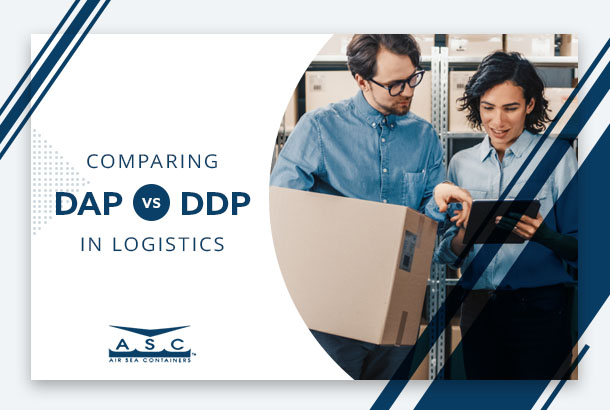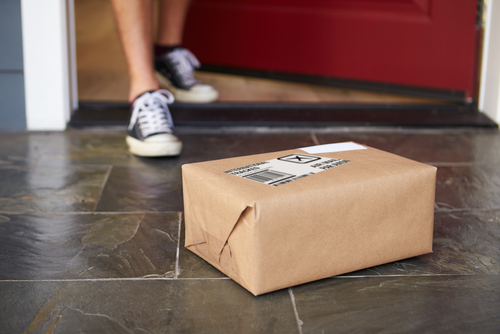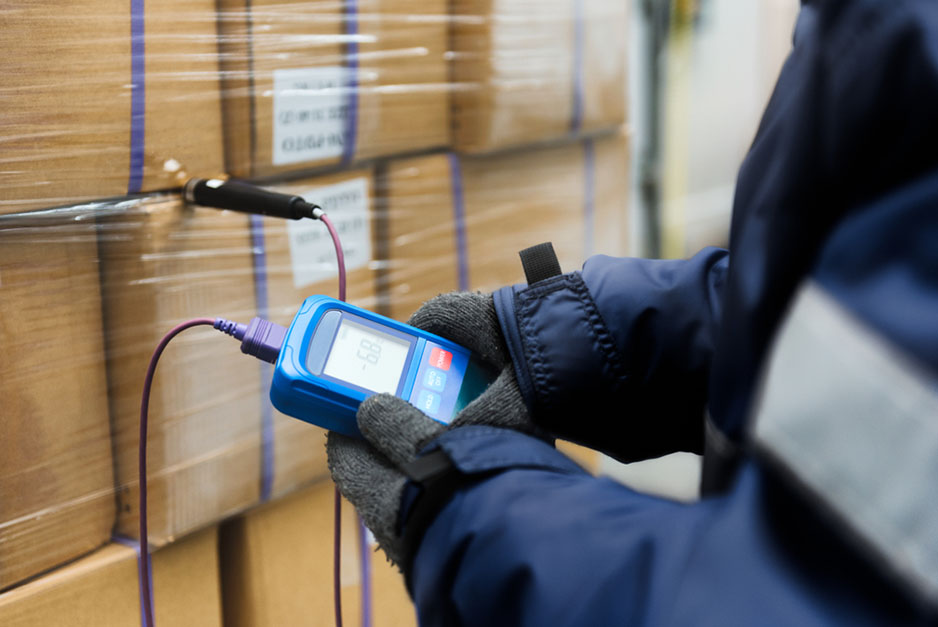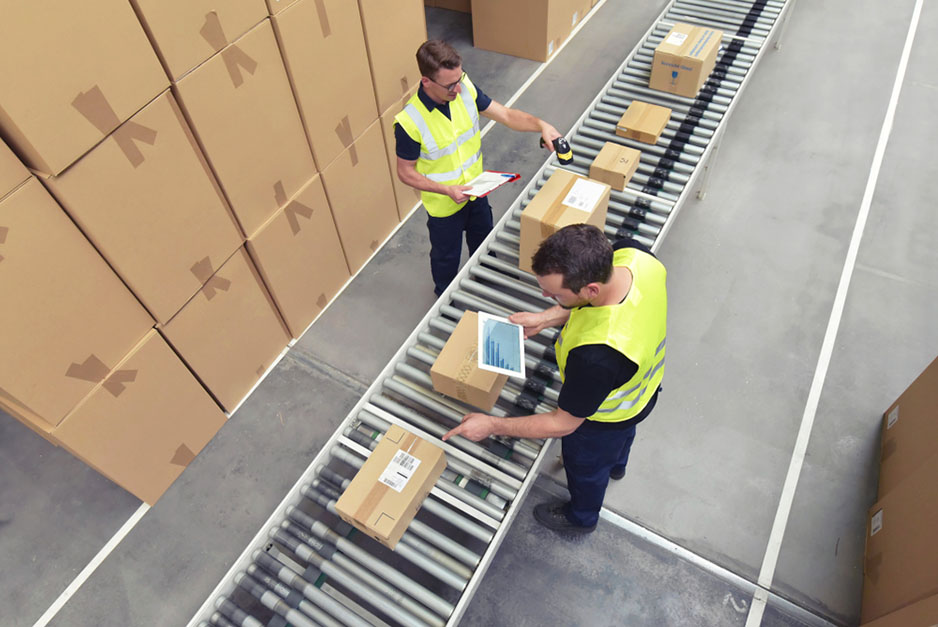Two of the most common sets of Incoterm rules are Delivered At Place (DAP) and Delivered Duty Paid (DDP). The difference between the two is unimportant for domestic shipments, but anyone who buys or sells goods internationally needs to understand DDP’s potential costs.
In short, DDP requires the seller to handle everything except the unloading of the goods at their destination. Every other step of the shipping and logistics process is the seller’s responsibility to organize and pay for, even if it ends up being more than expected.
Make Sure to Properly Label With Hazmat Shipping LabelsDAP, previously known as Delivery Duty Unpaid (DDU), requires the buyer to handle customs logistics and costs. Although this makes things easier for the seller, it can open up the potential for conflict and misunderstandings in the shipping process.
Before we go further, here are five things you need to know:
- DAP and DDP are Incoterms designating the risks and responsibilities of each shipping party.
- Both DAP and DDP place the bulk of responsibility for costs and logistics on the seller.
- DAP involves less paperwork for the seller and has lower costs than DDP.
- DDP offers more control for the seller regarding packaging, transportation and navigating customs.
- DDP allows sellers to build shipping, insurance and logistical costs into the overall cost of freight to mitigate their losses.
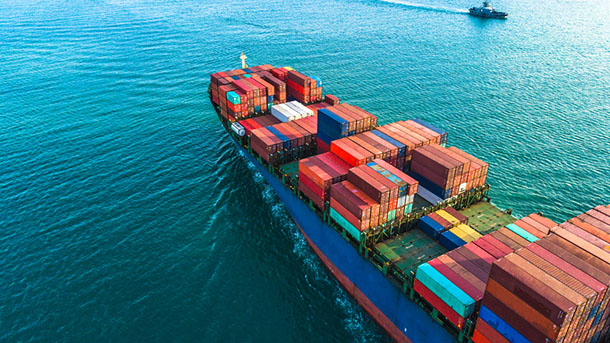
Preparing the Package and Arranging Shipment
Both DAP and DDP make most of the shipment process the responsibility of the seller. This includes warehousing, land transportation and ocean or air transportation that crosses international boundaries.
The costs and logistics associated with packaging and labeling the shipment are always the responsibility of the seller. This includes ensuring the weight and quantity printed on the label are accurate, to avoid delays with customs or the shipment itself.
This also includes hazmat shipping labels, special protective packaging and adhering to restrictions on packaging types. Although the seller cannot bill the customer directly for each of these costs, the seller can account for them in the overall shipping cost negotiated with the customer. Any last-minute increase in costs is the seller’s responsibility to absorb.
Arranging Shipment
Even when customs is left up to the buyer, these initial steps in the process require a surprising amount of work. Weather, transportation disruptions, changes in export laws and other logistical obstacles can significantly delay shipments. It’s the seller’s responsibility to navigate these obstacles and additional costs as much as possible, especially for extra-large containers with special requirements like shipping drums.

It’s common for sellers to use 3PL logistics companies as partners for shipping and warehousing for both DDP and DAP. If you’re asking “What is 3PL logistics?,” The short answer is it’s essentially outsourcing your logistics for shipping. Although even larger companies use 3PL contractors, they’re essential for smaller sellers that either don’t have enough full-time staff for international logistics or only export occasionally.
3PL companies can help with warehousing and exporting in addition to importing, so they have a range of potential uses even for sellers who only make DAP shipments. They usually have excellent relationships with ocean and air freight companies, making it easier to get good rates and keep your shipments moving even during inclement weather.
A Styrofoam Shipping Cooler Keeps Perishables and Other Goods at a Specific Temperature
Export Procedures
Export procedures vary widely depending on the type of goods, the country of origin and the destination country. In some cases, export officials check all the same paperwork importing officials check and hold shipments back if they don’t meet requirements. This is more common for countries under robust trade agreements like the United States-Mexico-Canada Agreement (USMCA).
DDP and DAP keep the export process solely as the seller’s responsibility because it’s far easier for the seller to navigate their home country’s export process. Many countries’ export authorities would struggle to deal with international buyers directly because of language barriers, time zone differences and phone call cost issues.
If a seller is uncomfortable handling the export process themselves, their best option is to partner with a 3PL service that provides extensive support for export paperwork. A 3PL service knows the ins and outs of certificates of origin, restrictions on electronics exports and other potential sticking points, which neither the buyer nor seller may be well-versed in. Some products require a license to export, and it is the seller’s responsibility to keep this license up to date and in compliance.
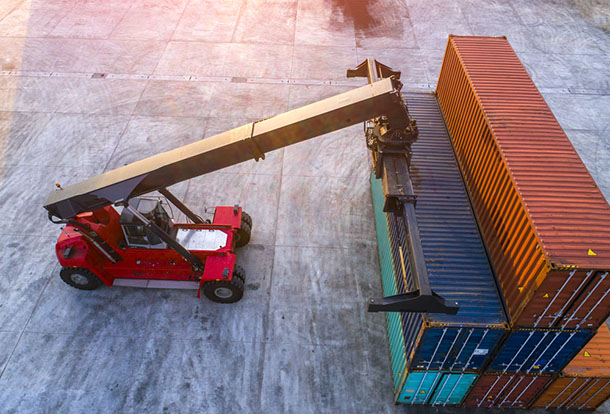
Handling Customs
Import procedures are even more thorny than export procedures. Many countries have quota restrictions on importing certain goods, requiring advanced notice of importing or having strictly defined tariff categories that can cause obstacles in the importing process. Incorrect or missing paperwork can cause delays at best and destruction of the offending goods at worst.
Many buyers or sellers choose to enlist the services of a customs broker to smooth out the process. A customs broker is experienced in dealing with the customs laws’ ins and outs and resolving issues quickly. If you already have a 3PL logistics service, talk to them first about customs brokerage, as they may have their own agent.
If you’re buying goods from abroad, keep in mind, it’s sometimes easier for customs officials to charge you for customs fees than the seller, even if you agreed on DDP terms. This is because of the amount of hassle involved in pursuing international sellers for taxes or legal fines. In these rare cases, buyers may need to pay the customs agents themselves and then send the seller the invoice for the mistake.
Some products require a license to import and, ultimately, it’s the buyer’s responsibility to have this license. For DAP shipments, the buyer will have to directly provide all the paperwork to the customs officials or broker. For DDP shipments, the buyer typically provides the paperwork to the seller, who gives it to the customs agents. However, this procedure may vary depending on the destination country.
Drayage and Final Delivery
Drayage to the buyer’s requested destination is the seller’s responsibility, even if the import duties and fees are the buyer’s responsibility under DAP terms. The buyer often takes care of remaining customs issues via phone or with a customs broker before the goods are placed on a truck arranged by the seller.
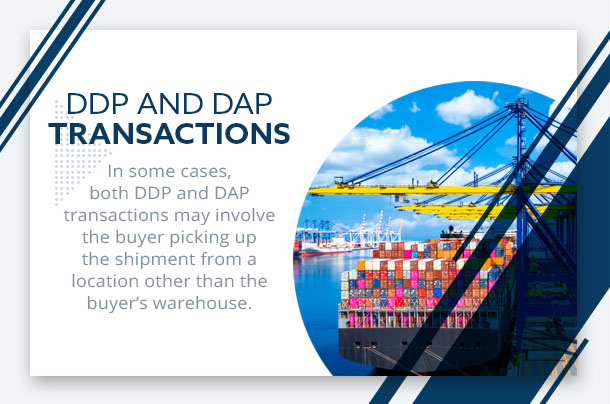
Drayage and any remaining intermodal transportation may include rail or truck. The costs and potential obstacles vary widely depending on how close to the port or terminal the final destination is. However, this step in the shipping process is usually much less work than customs paperwork and is less subject to delays.
One big potential issue is the destination’s definition, as it is not necessarily the buyer’s warehouse. In some cases, both DDP and DAP transactions may involve the buyer picking up the shipment from a location other than the buyer’s warehouse. If the buyer is picking up the goods from a terminal like a port or customs facility, though, then typically Delivered at Terminal (DAT) terms are used, which are almost identical to DAP other than the destination.
Insurance Considerations
Although not required, both DAP and DDP shipments should be insured by the seller to prevent unnecessary losses. Insurance costs vary dramatically, depending on the distance, mode of transportation and contents of the container.
In some cases, ships and air carriers have ways to compensate sellers for goods damaged or lost during shipment. However, major catastrophes may result in a general average being declared for all goods on board the ship, requiring sellers to chip in for the damage’s cost. Although this is extremely rare, consider investing in insurance covering the general average, as the cost per sender can add up to tens of thousands of dollars or more.
Overall Pros and Cons
Generally, DDP and DAP’s pros and cons are the same, regardless whether you ship large or small shipments. Both Less-Than-container Load (LTL) and Full Container Load (FCL) shipments see similar cost divisions, but sending multiple separate LTL shipments creates more customs paperwork. If your buyer insists on receiving goods as they become available instead of waiting for a full container’s worth, consider asking them to handle the customs paperwork or charge extra for the administrative labor.
DAP shipping is less work for the seller and more work for the buyer. It also costs less for the seller because all duties and fees are passed on to the buyer.

However, the seller can charge more for DDP shipping, including a little extra for overhead costs, because of the work involved. So, even though the seller can’t charge directly for the cost of customs and taxes, the seller can still build it into the overall price.
DDP introduces an extra variable that affects the seller’s bottom line, though. Although customs duties and taxes are relatively easy to predict, unforeseen delays can damage perishable goods, which is why it is vital to protect perishables with a styrofoam shipping cooler or other insulated or temperature-controlled packaging. Since the customs process is the seller’s responsibility, any damage to goods becomes the seller’s risk.
DAP shipping can be prone to delays if any communication breakdown occurs between the seller and the buyer or if the buyer’s customs process has unexpected difficulties. Although the seller will not necessarily be held liable for the breakdown, it may damage the buyer and seller’s relationship. Buyers don’t necessarily understand the complexities of customs and importing, so they may unnecessarily blame the seller.

Avoiding Misunderstandings
Newer businesses, in particular, may not know what to expect from a seller or certain Incoterms. Although it is not necessarily the seller’s responsibility to educate the buyer, having a brief conversation about the expectations is a standard best practice. Sellers can further protect themselves by staying up to date on emerging logistics strategies.
If you agree on DAP Incoterms and the buyer has questions about the process in their country, avoid giving them specific advice unless you are thoroughly versed in import-related matters. Giving them inaccurate information could damage your relationship later. Instead, advise them to contact a customs broker, even if this makes the process a little more difficult for them.
If you’re the seller, make sure the buyer understands you won’t mark a shipment as a gift or sample just to avoid taxes or tariffs. This is nearly impossible to do with larger shipments, but some small buyers may request it. Doing so can get both you and the seller in legal trouble with your respective countries.
Even with all the risks on the seller’s shoulders, DAP and DDP are still much more popular than EXWorks (EXW), a set of Incoterms that places nearly all the risk on the buyer. DAP and DDP are designed to leave the difficulties of international shipping in the hands of sellers that do international commerce all the time, rather than in the hands of a buyer that might have limited experience.
Making the Right Choice
DDP and DAP offer similar risks and rewards, especially in the broader context of other Incoterms. However, the few subtle differences may result in hundreds or thousands of dollars in taxes or even the loss of an entire shipment.
Since both terms place all liability with the seller up until the goods reach customs, it’s easy to assume the most important part of both Incoterms for the seller is the international leg. The customs procedures are easy to overlook, especially since customs officials are cautious about double-checking details air and ocean carriers might not.

DDP has an additional risk for the seller because of all the potential delays and extra costs at customs. However, most common consumer goods won’t encounter problems. Hazardous materials, electronics, produce and lumber are examples of goods that may encounter problems if the proper rules and certifications are overlooked.
DAP may be a more appropriate choice for buyers who are well-versed in local customs procedures or who are willing to assume responsibility for one of the most difficult parts of the shipping process. This can result in communication issues or blame being unfairly assigned to the seller, though.
Overall, DDP and DAP require substantial attention to detail for everything from tariff restrictions to packaging materials. Even if you’re using a 3PL provider, make sure your labels and packaging are in order before sending a package out the door. Avoiding delays and misunderstandings starts with clear communication and paperwork.
Image Credits
sutadimages/shutterstock.com
Iam_Anupong/shutterstock.com
Avigator Fortuner/shutterstock.com
Pakorn Khantiyaporn/shutterstock.com
Vitpho/shutterstock.com
CrispyPork/shutterstock.com
Gorodenkoff/shutterstock.com

